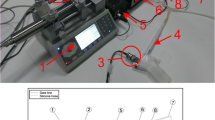Abstract
The paper studies the action and clinical significance of a reflex termed the ‘cervicocavernosus’ reflex. Twenty-two healthy women (mean age 39.7±10.2 SD years) entered the study. The cervix uteri was stimulated both mechanically and electrically by a needle electrode. The response of the bulbo- and ischiocavernosus muscles was recorded by a needle electrode inserted in each muscle. In 10 subjects, the cervix was anesthetized and the cavernosus muscles' response to stimulation of the anesthetized cervix was recorded. The vaginal pressure was measured at rest and on cervical stimulation by means of a balloontipped catheter introduced into the vagina. The mean vaginal pressure at rest was 5.2±1.8 SD cmH2O and on cervical stimulation 38.8±10.6 cmH2O. The cavernosus muscles showed no resting activity. Upon cervical stimulation, the muscles contracted with a mean amplitude of 286.4±55.6 SD μV for the bulbocavernosus muscle and 176.6±48.8 μV for the ischiocavernosus muscle; the mean latency of the reflex response was 59.2 ±10.6 SD ms. Stimulation of the anesthetized cervix did not evoke contraction of the muscles. The cervicocavernosus reflex could play a role in enhancing both clitoral and penile erection during the sexual act.
Similar content being viewed by others
References
Masters WH, Johnson VG. Human sexual inadequacy. Boston, Little, Brown and Co., 1970;187–192
Bors E, Comarr AE. Neurological disturbances of sexual function with special references to 629 patients with spinal cord injury. Urol Survey 1960;10:191–222
Guyton AC. Prepregnancy reproductive function in the female and the female hormones. In: Human physiology and mechanisms of disease. 4th ed. Philadelphia, W. B. Saunders, 1987;629–639
Pohl CR, Knobil E. The role of the central nervous system in the control of ovarian function in higher primates. Ann Rev Physiol 1982;44:583–585
Semans JH, Langworthy OR. Observations on the neurophysiology of sexual function in the male cat. J Urol 1938;40:836–846
Kuntz A. The autonomic nervous system. 4th ed. Philadelphia, Lea & Febiger, 1953; 295–296
Root WS, Bard P. The mediation of feline erection through sympathetic pathways with some remarks on sexual behavior after deafferentiation of the genitalia. Am J Physiol 1947;151; 80–90
Kuhn RA. Functional capacity of the isolated human spinal cord. Brain 1950;73:1–51
Zeitlin AB, Cottreli TL, Lloyd FA. Sexology of the paraplegic male. Fertil Steril 1957;8:337–344
Munro D, Horne HW Jr, Paull DR. The effect of injury to the spinal cord and cauda equina on the sexual potency of men. New Engl J Med 1948;239:903–911
Talbot HS. The sexual function in paraplegia. J Urol 1955;73:91–100
Bors E, Comarr AE. Effect of pudendal nerve operations on the neurogenic bladder. J Urol 1954;72:666–670
Weiss HD. The physiology of human penile erection. Ann Int Med 1972;76:793–799
Warwick R, Williams PL. Gray's anatomy. 35th ed. London, Longman, 1975;532
Adrian ED, Bronck DW. The discharge of impulses in motor nerve fibers. J Physiol Lond 1929;67:119–151
Rosenfalck P. Electromyography: sensory and motor conductions. Findings in normal subjects. Rijkshospitalet Laboratory of Clinical Neurophysiology, Copenhagen, 1975
Karacan I, Alsan C, Hirshkowitz M. Erectile mechanisms in man. Science 1983;220:1080–1086
Lue TF. The mechanism of penile erection in the monkey. Sem Urol 1986;4:217–223
Lue TF. The erectile mechanism. In: The scientific basis of sexual dysfunction. US Government Printing Office. Publication No. 491-292, 41090, 1986;4–7
Fournier GR, Juenemann KP, Lue TF, Tanagho EA. Mechanism of venous occlusion during canine penile erection: anatomic demonstration. J Urol 1987;137:163–179
Author information
Authors and Affiliations
Rights and permissions
About this article
Cite this article
Shafik, A. The cervicocavernosus reflex: Description of the reflex and its role in the sexual act. Int Urogynecol J 4, 70–73 (1993). https://doi.org/10.1007/BF00376415
Issue Date:
DOI: https://doi.org/10.1007/BF00376415




